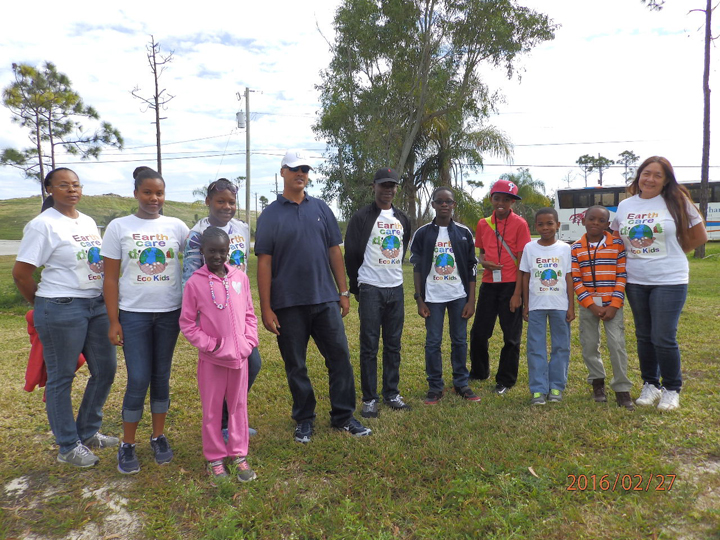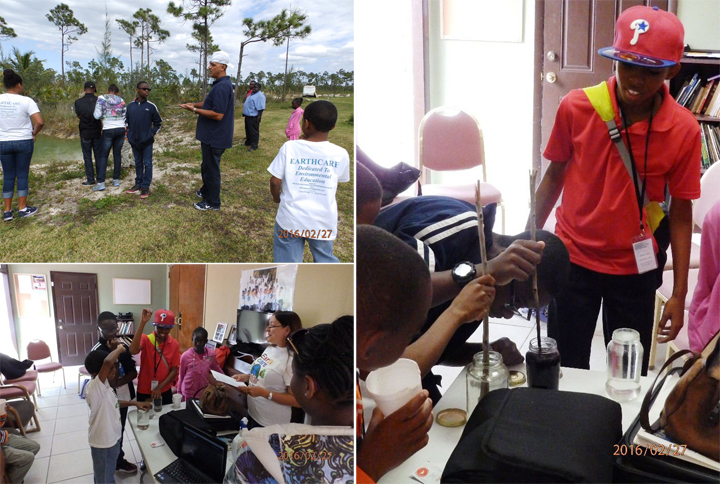|
From:TheBahamasWeekly.com Community
On February 27th, 2016, the EARTHCARE Eco Kids tackled the touchy subject of pollution. Gail Woon, Founder of EARTHCARE and a Director of Save The Bays met with the EARTHCARE Eco Kids and gave the students an overview of Pollution and its ramifications for our country. The topic was pollution. At the Kevin Tomlinson Academy, Ms. Woon spoke about the differences between the 3 types of pollution: ground, air and water. She explained that the City Water on Grand Bahama is pulled from the ground. Our ground is very porous and pollutants will be readily absorbed. This is why it is very important not to pollute the ground. She spoke about various types of water pollution, especially those that detrimentally affect our coral reefs and inshore areas. The students learned about Air Pollution and its ties to Climate Change (a change in global or regional climate patterns, in particular a change apparent from the mid to late 20th century onwards and attributed largely to the increased levels of atmospheric carbon dioxide produced by the use of fossil fuels). The students performed exciting experiments that illustrated various forms of Water Pollution.
“Pollution is a very serious problem in the Bahamas and the world. However, with the porous nature of our ground made of limestone, calcium carbonate, when pollutants are dumped on the ground they seep into the limestone substrate and into the freshwater lens that supplies our drinking water. We have air pollution issues as well. Thankfully we have steady winds and much of the air pollution is moved. Sadly, our air pollution contributes to Climate Change which will eventually have very detrimental effect s on our Bahamian islands, such as Sea Level Rise. In places like Nassau on New Providence, and Pinder’s Point on Grand Bahama the air pollution can be so bad at times that people suffer ill health effects such as asthma, breathing difficulties and even cancer.
Water Pollution is an important issue especially now that we have oil exploration looming on our doorstep. We have oil spills regularly on Grand Bahama and New Providence. I have had reports of trucks that transport septic tank waste dumping raw sewage into the canals of Grand Bahama at night in years past. Runoff from the land contributes to polluting our waters. This runoff can include the chemicals used in inorganic fertilizers from farms and golf courses. A good example of where NOT to build a golf course, is Baker’s Bay. The coral reef scientists predicted that the nitrates and phosphates running off from the golf course built on the beach, would cause eutrophication (nutrient pollution from fertilizers). The algae that are indicators of nutrient pollution are proliferating now in the shallow water on the beach by the golf course at Baker’s Bay and the reefs nearby are being overgrown with macro algae”, said Gail Woon. Samia Rampersad, Angelina Rahming and Tristan Rampersad,EARTHCARE Eco Kids Team Leaders assisted the group in hands on activities to illustrate the effects of pollution on our environment. Next, the EARTHCARE Eco Kids went to the Pine Ridge Landfill, a State of the Art for the Caribbean model for Sustainable Waste Management. Jason Albury, Manager of the Pine Ridge Landfill, graciously led a tour of the facility which is a model for the Caribbean region. “The Pine Ridge Landfill boasts a 100% Bahamian Staff. Vehicle tires are shredded so they don’t pose a flammable hazard within the Landfill. Used Oil is recycled at the Landfill. The Landfill is lined by 3 layers of protection to keep the wastes deposited from leaking into the freshwater table. Liquid leachate (“garbage juice”) is drawn off and evaporated in a collecting pool. Methane gas is removed regularly from the landfill and burned.” All in attendance were amazed at the lack of smell. Our landfill is “State of the Art” for not just the Bahamas but the entire region. There are two fish ponds at the entrance and goats graze the perimeter of the property, natural lawnmowers. The students were very impressed after this part of the field trip. Then it was on to the Industrial Area where the students viewed the various industries and learned about the history of pollution issues in the area and why schools had to be relocated because of the environmental hazards of pollution. Things you can do to help:- Do not dump pollutants on the ground. Educate persons about pollution. Keep your car tuned so that it does not emit noxious fumes that will contribute to climate change. Report to authorities if you see an industry creating air/water or ground pollution. Report situations where the water is polluted by oil or other chemicals. Sign the Save the Bays Petition to put Environmental Protection legislation in place so that there will be stiff penalties if a polluter pollutes. EARTHCARE would like to thank our sponsors, Kevin Tomlinson Academy, Pizza Hut, H. Forbes Charter & Tours and the parents/guardians who without their support this programme would not be possible. For more information about the EARTHCARE Eco Kids programme contact Gail Woon, earthcare.bahamas@yahoo.com or call 727-0797.
|


